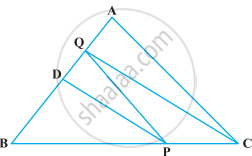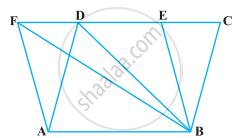Advertisements
Advertisements
प्रश्न
In ∆ABC, D is the mid-point of AB and P is any point on BC. If CQ || PD meets AB in Q (Figure), then prove that ar (BPQ) = `1/2` ar (∆ABC).

उत्तर

Given: In ∆ABC, D is the mid-point of AB and P is any point on BC.
CQ || PD means AB in Q.
To prove: ar (∆BPQ) = `1/2` ar (∆ABC)
Construction: Join PQ and CD.
Proof: Since, D is the mid-point of AB. So, CD is the median of ∆ABC.
We know that, a median of a triangle divides it into two triangles of equal areas.
∴ ar (∆BCD) = `1/2` ar (∆ABC)
⇒ ar (∆BPD) + ar (∆DPC) = `1/2` ar (∆ABC) ...(i)
Now, ∆DPQ and ∆DPC are on the same base DP and between the same parallel lines DP and CQ.
So, ar (∆DPQ) = ar (∆DPC) ...(ii)
On putting the value from equation (ii) in equation (i), we get
ar (∆BPD) + ar (∆DPQ) = `1/2` ar (∆ABC)
⇒ ar (∆BPQ) = `1/2` ar (∆ABC)
Hence proved.
APPEARS IN
संबंधित प्रश्न
The side AB of a parallelogram ABCD is produced to any point P. A line through A and parallel to CP meets CB produced at Q and then parallelogram PBQR is completed (see the following figure). Show that
ar (ABCD) = ar (PBQR).
[Hint: Join AC and PQ. Now compare area (ACQ) and area (APQ)]

ABCD is a trapezium with AB || DC. A line parallel to AC intersects AB at X and BC at Y. Prove that ar (ADX) = ar (ACY).
[Hint: Join CX.]
Diagonals AC and BD of a quadrilateral ABCD intersect at O in such a way that ar (AOD) = ar (BOC). Prove that ABCD is a trapezium.
Diagonals AC and BD of a quadrilateral ABCD intersect each other at P. Show that ar (APB) × ar (CPD) = ar (APD) × ar (BPC).
[Hint : From A and C, draw perpendiculars to BD.]
P and Q are respectively the mid-points of sides AB and BC of a triangle ABC and R is the mid-point of AP, show that
(i) ar(PRQ) = 1/2 ar(ARC)
(ii) ar(RQC) = 3/8 ar(ABC)
(iii) ar(PBQ) = ar(ARC)
In a ΔABC, if L and M are points on AB and AC respectively such that LM || BC. Prove
that:
(1) ar (ΔLCM ) = ar (ΔLBM )
(2) ar (ΔLBC) = ar (ΔMBC)
(3) ar (ΔABM) ar (ΔACL)
(4) ar (ΔLOB) ar (ΔMOC)
The area of the parallelogram ABCD is 90 cm2 (see figure). Find
- ar (ΔABEF)
- ar (ΔABD)
- ar (ΔBEF)

A point E is taken on the side BC of a parallelogram ABCD. AE and DC are produced to meet at F. Prove that ar (ADF) = ar (ABFC)
The medians BE and CF of a triangle ABC intersect at G. Prove that the area of ∆GBC = area of the quadrilateral AFGE.
In the following figure, CD || AE and CY || BA. Prove that ar (CBX) = ar (AXY).

